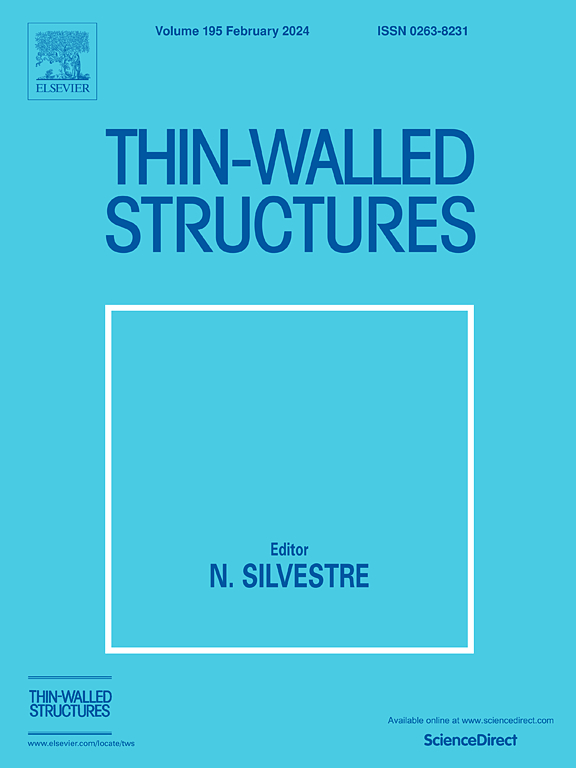铝合金板材屈曲行为研究--复合材料修补前后
IF 5.7
1区 工程技术
Q1 ENGINEERING, CIVIL
引用次数: 0
摘要
本文研究了带有不同大小椭圆孔洞的铝合金薄板的压缩屈曲行为。为了提高这些薄板的稳定性,使用了 T700/QY8911 复合材料层压板作为修补孔的补片。研究包括使用实验和数值方法分析临界和临界后行为。实验的重点是屈曲载荷、屈曲后行为以及孔洞尺寸与屈曲载荷之间的关系。同时,通过有限元分析确定屈曲载荷和屈曲模式,使用特征值问题模式的线性分析,然后对具有初始几何缺陷的结构进行非线性分析,研究其屈曲后行为、破坏行为和载荷传递。结果表明,开孔试样的屈曲载荷与开孔尺寸有关。补丁的存在对应力分布有显著影响,修复后试样的屈曲能力明显优于无孔试样。压缩实验结果与数值结果一致,表明所建立的结构有限元模型是正确的。本文章由计算机程序翻译,如有差异,请以英文原文为准。
Study on the buckling behavior of aluminum alloy sheets - before and after repaired with composite patches
In this paper, the compressive buckling behavior of aluminum alloy plates with an elliptical hole of various sizes is investigated. In order to improve the stability of these thin plates, T700/QY8911 composite laminate is used as a patch to repair the hole. The study included an analysis of the critical and post-critical behaviour using experimental and numerical methods. Experiments focus on buckling loads, post-buckling behavior and the relationship between sizes of holes and buckling load. Meanwhile, the buckling load and buckling mode are determined by finite element analysis, using linear analysis of eigenvalue problems modes, and then, the nonlinear analysis of structures with initiated geometrically imperfection is carried out, studying its post-buckling behavior, damage behavior and transfer of load. The results show that the buckling load of the open-hole specimen is related to size of opening. The existence of patch has a significant influence on stress distribution, and the buckling capability of repaired specimens is noticeably improved to the plate without a hole. And the compression experimental results are consistent with the numerical results, revealing that the developed finite element model of the structure is correct.
求助全文
通过发布文献求助,成功后即可免费获取论文全文。
去求助
来源期刊

Thin-Walled Structures
工程技术-工程:土木
CiteScore
9.60
自引率
20.30%
发文量
801
审稿时长
66 days
期刊介绍:
Thin-walled structures comprises an important and growing proportion of engineering construction with areas of application becoming increasingly diverse, ranging from aircraft, bridges, ships and oil rigs to storage vessels, industrial buildings and warehouses.
Many factors, including cost and weight economy, new materials and processes and the growth of powerful methods of analysis have contributed to this growth, and led to the need for a journal which concentrates specifically on structures in which problems arise due to the thinness of the walls. This field includes cold– formed sections, plate and shell structures, reinforced plastics structures and aluminium structures, and is of importance in many branches of engineering.
The primary criterion for consideration of papers in Thin–Walled Structures is that they must be concerned with thin–walled structures or the basic problems inherent in thin–walled structures. Provided this criterion is satisfied no restriction is placed on the type of construction, material or field of application. Papers on theory, experiment, design, etc., are published and it is expected that many papers will contain aspects of all three.
 求助内容:
求助内容: 应助结果提醒方式:
应助结果提醒方式:


